How to Build a Dog Sled Easy
If it's a sled with wheels, isn't it just a cart?
Well, that's up to you—building a dog sled with wheels is a great way to have your dog help you with hauling things around the yard, or if you have multiple, you can set up an area to sit and have them lead you around like a traditional dog sled. The choice is yours.
Either way, we're going to show you how to make a pretty fantastic dog sled with wheels. This design is not intended to come off the wheels, because placing axels is difficult to do with a sled bottom in mind. It's time to get to work.
What Are Dog Sleds?

By definition, these are sleds designed for humans to sit in, with one or multiple areas for sled dogs to pull the sled across snow and ice.
Dog sleds are usually made out of a lacquered wood to stay nice and smooth on the ground, and are very close to the ground (no rise on the sides). Dog sleds are basic and lightweight because dogs can only hold so much.
A dog sled can also be a small sled designed just for lightweight, small batches of cargo. These usually hook up to a single dog via lightweight wooden beams and a harness.
These smaller sleds can also be pulled with one or two children in the back, provided that the child knows how to control the dog.
History of Dog Sleds
Would you believe that dog sleds actually go back to 2000 B.C.?
Although archaeological evidence points closer to 1,000 A.D., some texts and imagery point to a much earlier inception. We don't really have many artifacts that are over 4,000 years old though.
While this mode of transit wasn't new, it was revolutionized by a man named Jacques Cartier in 1534 when he discovered the Gaspe Peninsula via dog sled. This popularized the mode of travel for quite some time afterwards.
As time marched on and dog sledding was seen as a proper mode of transportation through winters and snowy terrain, (mostly in Canada), it was also recognized as a sport. There wasn't much to do in these long winters, so dog sledding teams would race across a preset area for first place.
Over time, dog sledding teams went from two dogs up to six and eventually even more, figuring that more power meant less drag and more consistent high speeds. We were racing dogs even back then, in a sense. Apart from that, dog sledding doesn't have a crazy long history.
Dog sled designs have remained pretty much the same for a long time simply because they work. Wood still works best, since many modern materials can't withstand the cold of ice and snow while remaining durable. It goes inline with that whole "If it isn't broke, don't fix it" motto that we've all heard before.
What Breeds Can Pull a Dog Sled?
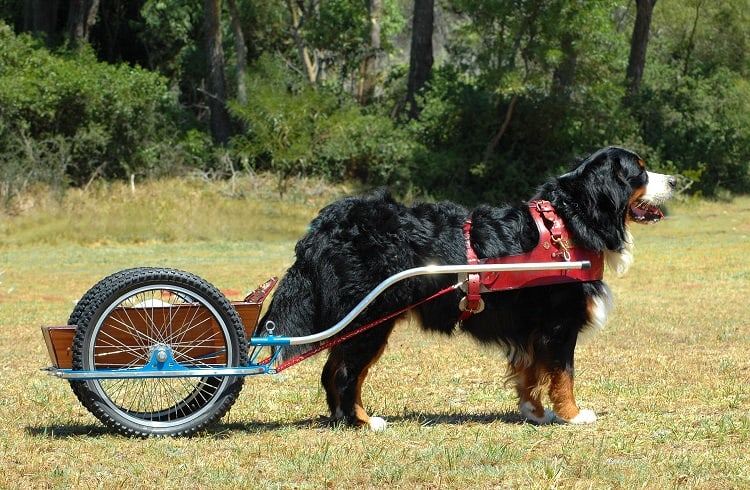
Technically, a lot of medium to large breeds can pull sleds, but it's not just about having the muscle to make the sled glide on ice.
There are specific breeds that have been bred to do this, or at least survive in the harsh winter conditions without being affected too much. This is a quick list of those breeds.
- Siberian Husky: With some of the highest cold tolerance of any dog, not to mention their fantastic stamina and top-tier strength, Siberian huskies have been the go-to for most dog sledders throughout history.
- Alaskan Malamute: Resistant to cold and built bulky, Alaskan malamutes have a long life expectancy, making them perfect sled racing dogs for years before their seniority retires them from sports.
- Samoyed: While these adorable dogs can seem smaller than expected, they're actually fairly strong, and in groups can pull dog sleds. Resistance to the cold and a long life expectancy make them reliable sled dogs.
- Chinook: While chinooks are good sled dogs, they have the least resistance to cold, but some of the best stamina and constitution for long-winded dog sledding races.
These are your four best breeds to help pull a sled without being majorly affected by the cold.
What do I Need to Make a Dog Sled?
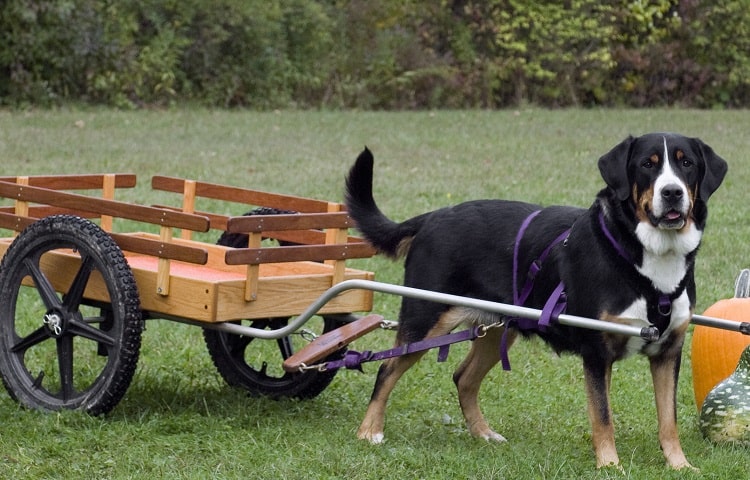
We're going to have two versions available: an all-wood version, and an inexpensive shortcut version. For each, you will need the following.
All Wood Version
I hope you have a few woodworking tools available, because if not, you're going to have to run to Lowe's and get some full day rentals to make sure that you can make this properly.
This is a dog sled that you'll be proud to show off once all the finishing is completed. While this only takes a day to assemble, letting the lacquering dry will take 48-72 hours, so be prepared for that.
- 2" x 4" OR 2" x 6" pressure-treated lumber, about 12 ft
- 1" x 1" framing lumber, about 20 ft
- Metal L brackets
- 20W drill
- ½" wood screws
- Wood glue
- PVC joints
- Ski boot tracks (Yaktrax works great)
- Fine grit sandpaper
- Wood lacquer
- Wood vice
Cheap Version
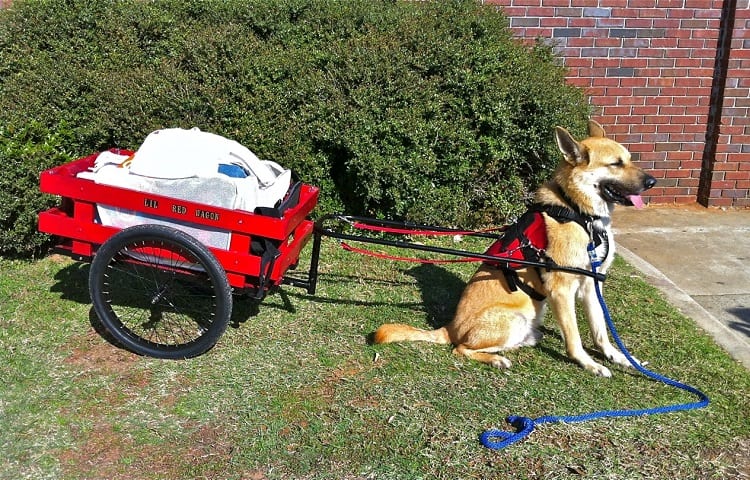
We call this the cheap version because if you buy most of these pieces, it's a one-day project to make your dog sled.
It also looks like a rigged version compared to a nice lacquered wooden piece, so it comes across looking cheap when in reality it's even more durable than the wooden version. This is what you need.
- 1 wide-armed dolly (with wheels)
- 1 metal snow shovel
- 1 pair of skis
- 2-4 heavy duty nylon harnesses
- 2 rubberized grips or spray-on rubber
- 1 pack of carabiners (always good to have these handy)
- 20W drill
- 1" metal screws (about a dozen or so)
- ¾" metal tubing (this will support your weight; don't cheap out)
- Metal or PVC corner connectors
- Soldering iron
Making Your DIY Dog Sled
You're not going for an award-winning, top-of-the-line dog sled here: you want something basic, inexpensive, and easy enough to DIY without making it a hundred-hour project.
We're also willing to bet that you don't have a dozen dogs in your employ to pull the sled, so being lighter and faster will be beneficial across the board.
All Wood Version

1. First, you need to cut your wood. This is a list of the cuts you'll need.
(12) 20" wood strips made from 1" x 1" framing wood
(3) 22" wood strips made from 1" x 1" framing wood
(2) 36" wood strips made from 1" x 1" framing wood
(2) 72" long 2" x 6" boards
(2) 46" long 2" x 6" boards
(2) 56" long 2" x 6" boards (cut at 45° angleson either end; you can cut these later to be safe)
2. We're going to make the cargo frame that will sit in front of you (picture for reference). Lay the two 36" wood strips vertically, the two 22" wood strips horizontally to make a box, and 20" wood strips every two inches apart along the inside of the box.
3. Use wood glue to attach each piece to one another. Use wood screws to finalize the frame.
4. Take your two 72" long 2" x 6" boards and soak them in water for sixty minutes. We need to bend the front to create a slope like in the reference picture.
5. Once the boards have soaked, use a vice to hold them in place and bend them. This guide on bending wood with water is a good solution to help.
6. When the wood is finished being bent, let it dry for twenty-four hours at the least. Once it is dry, lay them down so the wood curves up as if it were laid down as a sled. Take your ski boot tracks and install them along the back of the boards, about 12-18" from the very back of the 72" boards.
7. Attach a PVC joint to the very tip of each 72" board at the height of the bend once it has dried. From here, you're going to attach the cargo bin we made earlier so that it runs from the tip of the sled backwards towards the rider area.
8. We could have pre-measured everything and installed it already, but wood bending is the variable here. The height of your cargo bin will vary, but once it's in place, attach the two 46" long boards at a 90° angle into the top of each ski side. These should stand straight up and meet at the back of the cargo bin. Screw these into place using PVC joints at the bottom, and attach them with screws and/or wood glue to the edges of the cargo bin.
9. (Optional) You can add side planks to the cargo bin for stability if you choose just like in the reference photo.
10. Take the 56" long boards and cut the bottom at a 45° angle. That angle should rest on the ski bottoms and run up to meet the top of the two vertical 46" wood boards. Once these meet, cut a 45° angle off the top of the 46" boards so that these become flush with one another. The remaining board section that resides on top of the vertical boards is intentional.
11. Sand down the extended section of the boards, and use the last 1" x 1" wood piece you made to create a handle. Attach this in between the height of the two boards with wood glue and screws.
12. Secure any areas that need it with metal L brackets.
13. Sand down the entire wooden dog sled.
14. Apply lacquer to the finished sled, and make sure it has time to dry for 48-72 hours. Inspect it to see if it needs an additional coat.
Caveats With This Dog Sled Type
Is it as strong as metal? Not at all, but it is durable, lightweight, and will last you for a long time. If you stain and seal it properly, it will also look fantastic when you want to show it off to other people.
The reason that we didn't go with wooden bars to secure the dog harnesses to is because not only do we not know how many dogs you want to use for this, but it may not be as durable or trustworthy in a DIY project as opposed to being commercially made.
Cheap Version
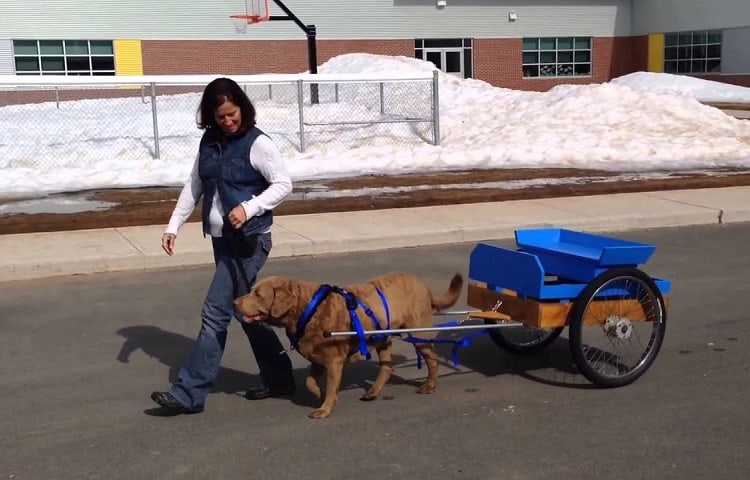
1. Start by taking the handle off of the snow shovel. It should detach right above the actual shovel head.
2. Position the dolly with the handles and wheels facing you. Measure about one inch above the highest point of the wheels, and make a marking on the back of the vertical dolly poles. On the dolly, there should be a crossbar to mark this spot; we need that crossbar to screw the piping into.
3. Take your ¾" metal piping and appropriate corners, and assemble them to make three fourths of a square. Three metal pipes, two corners.
4. Use your soldering iron to attach them to the crossbar. Use additional screws if necessary (at a 45° angle) to affix this in place. If you encounter wobbling, L brackets can be applied underneath to attach it to the vertical poles for extra stability.
5. Take the detached metal snow shovel head and lay it on top of the piping attachment. Use four metal screws to secure it in place. Depending on how sharp the shovel is, you might want to consider dulling it with a file for safety.
6. Remove any straps or foot enclosures from the top of your skis. When your dolly stands up perfectly straight, the wheels are level with the bottom of the dolly platform. You're going to attach your skis beneath these (metal screws through the bottom in two places per ski), and the wheels should sit just on top of them. The wheels are an option if you want to unscrew the skis at a later date to use this in the summer.
7. Once your dog is in the necessary harness, attach the nylon piece to the crossbar near the snow shovel standing area. You want weight to be pulled from the bottom so that you can maneuver yourself accordingly.
Caveats With This Dog Sled Type
It's not as safe as an all wooden sled because of the metal components, and you're banking on your dog slowing down properly or having enough resistance to stop without crashing into them.
The nylon strap works well, but it doesn't have a lot of stopping power. You can step backwards on this dog sled to apply pressure and get it to stop. It's arguably easier to make than the all wood version (especially if you don't have any woodworking tools), but I wouldn't call it easy in its own right.
Things to Watch Out for When Making a Dog Sled
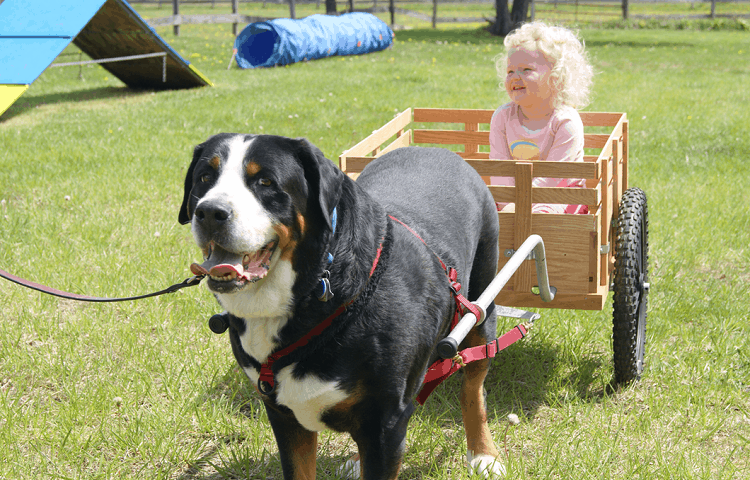
If you're going to DIY this, then you need to have certain aspects on-point. Let's go over absolute must-haves when making your dog sled, and some common blunders that you can avoid.
- Lacquer and Lacquer Again: If the coating of lacquer on your sled isn't very well pronounced, it's time to add some more. This is one step that you can't cheap out on; it will drastically impact performance. When you cut through powder and feel the frozen ground, lacquered wood will be able to glide across is better than bare wood. This also prevents wood swell from slush being absorbed by the wood fibers, keeping you steady the entire time.
- Inches, Not Miles: You might be thinking of all that you can do with your dog sled, like how many miles you can travel. Before you get carried away in your head, you need to double-check all of your measurements. One inch in height difference from the left side of your sled to the right can put major stress on the wood. On top of that, it will make for uneven weight distribution during pulling.
- Stopping Power: When you make your own sled, you'll notice that wooden rails help keep the dogs in place instead of just leashes. Why is that? Because when they come to a halt, your sled would just bash right into those poor doggies. When you make your own DIY dog sled, you have to make sure that you have the necessary stopping power to keep them safe, and so that it doesn't glide when you're trying to come to a stop as well.
Should I Make a DIY Dog Sled for my Kids?
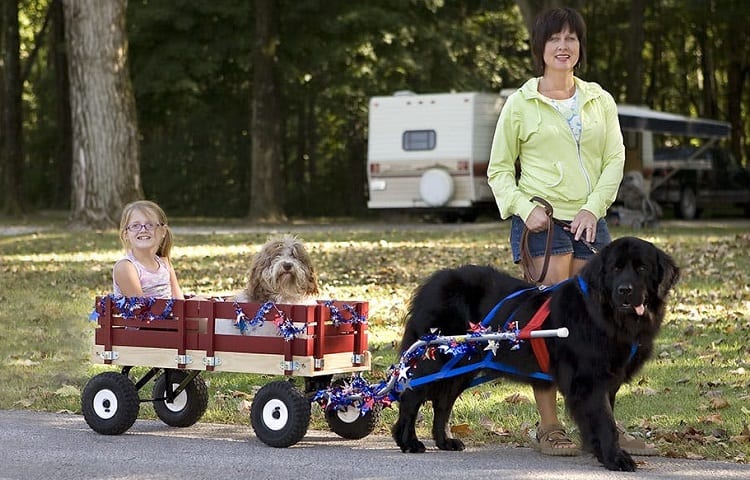
It could be a fun side project. If you have a family dog that you completely trust, you can make a sled for your kids, but there are obvious safety precautions that you have to keep in mind.
Your child needs to be at an age where they can assess risk and get off the sled if need be. This is more on a person-to-person basis than just age, but all I'm trying to say is that no three-year-old is going to look ahead and make a calculation about whether or not they're in danger, and then jump off on their own accord and from their own decision-making.
Your kids could have tons of fun with a dog sled if you make it properly. Just be sure that you give it a whirl first so that you know what to expect, and so that you can inspect it for safety.
The Ultimate Doggy Sled
Have your dogs help you haul things around, get hauled around, or take up a homemade dog sled business; the world's your oyster.
While this project can be time-consuming, when done right, you'll have a beautiful dog sled in your possession.
You always have the option of buying a dog cart or dog sled if the task proves too difficult at any point; just don't forget that it's an option.
Depending on your dog's weight, breed, and physical capabilities, that may be a solid choice if you can't properly scale a dog cart down to their size.

Dan is a well respected content researcher who has vast experience working projects in the pets niche. He is a frequent contributor to dogtemperament.com and loves delivering numerous helpful dog articles like this one that are read by thousands of our readers monthly.
Source: https://dogtemperament.com/dog-sled-with-wheels/
0 Response to "How to Build a Dog Sled Easy"
Postar um comentário